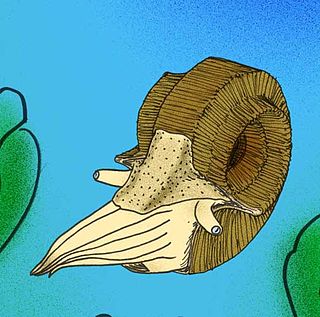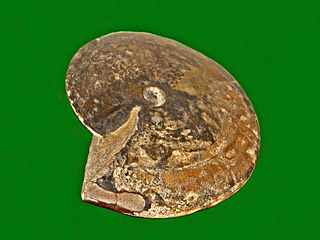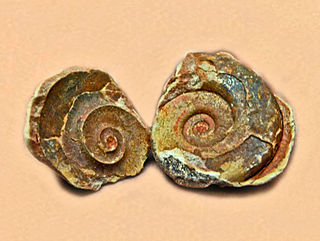 W
WAraxoceras is an extinct genus of ceratitid ammonites that lived in the Late Permian marine environments of Iran, South China and Japan. The various species had distinctive, angular-cornered shells.
 W
WAraxoceratidae is an extinct family of ceratitid ammonites, cephalopods that were found throughout the world. They arose during the Permian and died out during the early Triassic. The species of the type genus Araxoceras are used as markers for various Permian epochs.
 W
WArcestidae is an extinct family of ammonite cephalopods.
 W
WBalatonites is a genus of extinct cephalopods belonging to the ceratitid family Balatonitidae. There are at least four known species: B. balatonicus, B. oyama, B. shoshonensis, and B. zitteli.
 W
WBeloceratidae is a family of ammonites included in the order Ceratitida.
 W
WCatenohalorites is an extinct genus of Triassic ammonoids belonging to the family Haloritidae.
 W
WCeratites is an extinct genus of ammonite cephalopods. These nektonic carnivores lived in marine habitats in what is now Europe, during the Triassic, from the upper-most Anisian to the lower Ladinian age.
 W
WCeratitida is an order that contains almost all ammonoid cephalopod genera from the Triassic as well as ancestral forms from the Upper Permian, the exception being the phylloceratids which gave rise to the great diversity of post Triassic ammonites.
 W
WCeratitidae is an extinct family of ammonite cephalopods.
 W
WChieseiceras is an extinct genus of ammonites in the family of Ceratitidae. Species are known from the Triassic of Hungary, Italy and Switzerland.
 W
WClionites is a genus of the clydonitacean family Clionitidae, and its type. The shell is evolute so as to expose all whorls which are covered with generally bifurcating signmoidal ribs. The suture is ceratitid with two lateral lobes.
 W
WEtoushanocertidae is an extinct family of ceratitid ammonite cephalopods that were restricted to marine strata in Late Permian China.
 W
WGymnitidae is a family of Lower to Middle Triassic ammonite cephalopods with evolute, discoidal shells.
 W
WHalorites is an extinct genus of Triassic ammonoids belonging to the family Haloritidae.
 W
WHedenstroemia is an extinct genus of Early Triassic (Olenekian) cephalopods in the ammonoid order Ceratitida. They were nektonic carnivores.
 W
WHedenstroemiidae is an extinct family of cephalopods in the ammonoid order Ceratitida. They were nektonic carnivores.
 W
WOtoceratoidea is an extinct superfamily of ammonite cephalopods in the order Ceratitida.
 W
WOwenites is a genus of a ammonite from the early Triassic. Its size was only 33mm. It would eat mainly leftovers that it could find. Its shell was a crystal white color.
 W
WParaceltites is a genus of ammonoid cephalopods in the ceratitid family Paraceltitidae, known from the Middle and Upper Permian of Sicily, the Alps, Crimea, Texas and Mexico. The shell of Paraceltities is evolute with whorls compressed, venter arched and smooth, sides bearing ribs that slant somewhat forward dorso-ventrally. The suture is simple and goniatitic.
 W
WParaceratites is an extinct genus of ammonite cephalopods in the family Ceratitidae.
 W
WParaceratites subnodosus is an extinct species of ammonite cephalopods in the family Ceratitidae.
 W
WProtrachyceras is a genus of ceratitid ammonoid cephalopods belonging to the family Trachyceratidae.
 W
WPtychites is an extinct genus of cephalopods belonging to the family Ptychitidae. These nektonic carnivores lived during the Triassic period, from Anisian to Ladinian age.
 W
WThe Ptychitidae is a family of ceratitid ammonites. They are combined with the Eosagenitidae and Sturiidae in the superfamily Ptychitaceae.
 W
WThe Trachyceratidae is an extinct family of ceratitid ammonoid cephalopods.
 W
WThe Xenodiscaceae is a superfamily within the ammonoid order Ceratitida. The Xenodiscaceae, named by Frech in 1902, presently contains ten families, only one of which was included in the original Otocerataceae of Hyatt, 1900, the remaining having been added.
 W
WThe Xenodiscidae are the earliest of the Ceratitida and comprise Middle and Upper Permian genera characterized by compressed, discoidal, evolute shells with rounded to acute venters and commonly with lateral ribs. Sutures are goniatitic to weakly ceratitic.
 W
WXenodiscus is an extinct ammonoid cephalopod genus and one of the earliest ceratites, found in the Upper Permian of northern India and Timor. Xenodiscus is included in the family Xenodiscidae which is part of the ceratite superfamily Xenodiscaceae